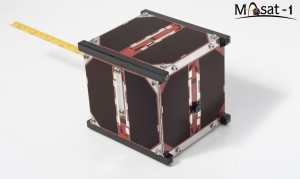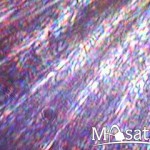On 21 and 22 March 2012 (Wednesday, Thursday) we will switch the satellite to silent mode again as a repetition of the last silent mode data aquisition. In silent mode, all RF transmission of the satellite is turned off, the satellite is only on reception. After these experiments regular telemetry transmission will be turned on again.
Planned schedule for 16 March
- at 23.27 UTC the satellite is commanded to silent mode
- at 00.57 UTC the satellite turns back to normal mode
This means that between 23.27 – 00.57 UTC the satellite’s transmitters will be turned off intentionally, to prevent the disturbance of sensitive EM measurements. According to the schedule, the satellite will turn back to normal mode automatically.
Masat-1, the First Hungarian Satellite made history again when it captured the first satellite space photographs on 8 March 2012 This first photo shows the southern section of the African continent. The next photos were made of Australia and Antarctica, in a quality and quantity unprecedented in the CubeSat realm.
Besides their sole beauty, these photos also demonstrate the careful planning and execution of the satellite’s operation, proving that even within the tight mass and energy constraints of Masat-1 it is possible to capture space images.
The on-board camera of Masat-1 has a mass of about two Euro coins. The maximal resolution is 640×480 pixels. A width of 1 pixel corresponds to a distance of 1 to 10 kilometres on the photos recorded.
The flawless operation of the passive attitude control system made it possible to capture photographs ahead of schedule, but with this passive system only the Southern Hemisphere of the Earth may be targeted by the camera. As the first month of the mission passed, almost every mission objective was fulfilled. The flawless run of the satellite opens a new scientific and technological horizon for experiments which we plan to perform in the coming months.
There is an increasing demand for Eath observation satellites worldwide both from the public and the private sector, as such spacecraft can capture on-demand, high resolution, up to date images of a specific area of the Earth’s surface. The captured images might be used for disaster relief operations, weather forecast services, crop yield estimation and tracking of agricultural operations, civil transport and cartography applications and also defence purposes.
Masat-1 First Photographs Taken During Flight
As part of the ESA Education programme, seven CubeSats designed and built by European universities were placed into orbit by Europe’s new Vega launch vehicle on 13th February 2012.
For more information please visit ESA’s Education CubeSat pages.
Summary
The first month of the mission was the most critical from the engineering perspective. Fortunately everything went in accordance with our highest expectations. Not only did the satellite survive the first month without a slightest error, but it also transmitted more than 20 MB of data about its operation and the space environment. What is more, Masat-1 was classified as an OSCAR satellite by AMSAT. This classification brought a new name (MO-72) and the inherent reputation.
This success would not have been possible without more than 100 radio amateurs tracking and receiving Masat-1 from all around the world. Their contributions have been invaluable, so it comes as no surprise that we kept their demands in mind while implementing the following:
- Continuous development of the decoding SW, from which the latest version was published on 12/03/2012.
- An online statistics page of the packages received by participating radio amateurs.
- On the home page of the website there is a continuous live display of the most important engineering parameters of the satellite.
- Within a few days the measurement data collected from the satellite will be published on a separate sub-site.
What has happened to the satellite so far?
Week #1 (13-19 February 2012)
We tested all on-board subsystems and functionalities to get a clear view of the satellite’s health. According to the received telemetry data it became evident that each subsystem of the satellite operates properly, in line with expectations. During the first few days the commanding of the satellite was tested, demonstrating that the satellite can be commanded by both the primary (Budapest) and the secondary (Érd) command station. Participating radio amateurs provided us the possibility to follow the satellite’s health even when it was not in LOS with our ground stations.
On 16 February Masat-1 was classified as an OSCAR satellite (Orbiting Satellite Carrying Amateur Radio). This classification testifies that Masat-1 (MO-72) is a satellite which operates well and transmits in the satellite’s radio amateur band. Masat-1 is the 72nd satellite in the world to be classified as such. From now on MO-72 is also an official name of the satellite.
Week #2 (20-26 February 2012)
The satellite’s orbit was planned such that only the second week had brought the first eclipse on-board. From this first occasion, each orbit had a section in eclipse, the dark section expanding steadily until the end of the 4th week. The first eclipse was considered critical, as that was the first occasion when the satellite had to run from the batteries, without energy provided by the solar cells. Besides, the continuous illumination also provided an additional heat, adding to the satellite’s temperature balance. The eclipse orbits resulted in a reduced average temperature and an elevated fluctuation of temperature.
The satellite’s temperature and energy balance remained appropriate, all functionalities performed well during the eclipses, inclusive of the 100mW and occasional 400mW RF transmission.
During the second week we started to download measurement data files from the satellite. The files recorded during the ejection, antenna opening and first orbits were downloaded first. In parallel, long term measurements were initiated to study the temperature and energy relations of the satellite during the lengthening eclipse periods.
Week #3 (27 February – 4 March 2012)
From the 3rd week, aside from data collection we concentrated on the evaluation and automated processing of the data obtained. The changes of thermal relations were tracked as the eclipse extended with each orbit.
Long term high-resolution measurements were performed with the instruments of the attitude determination and control system. With these measurement data, the calibration of the system started, which can be considered as a first step towards enabling the system.
Week #4 (5-11 March)
By the end of the first week of March (Week #4) we got an almost complete overview of the performance and characteristics of the on-board electronics and subsystems. The collected data proved that during the longest eclipses the battery temperature would have fallen below 5 °C, which is a critical level considering the energy balance. This fall of the battery temperature was prevented by the battery heating system, which was turned on time to time to convert some electric energy to raise the battery temperature and therefore the satellite’s internal temperature as well.
By the end of Week #4 the passive stabilization almost completely aligned the antenna axis with the magnetic field of the Earth. Meanwhile, the launch of the active stabilization is on hold while the sensors’ calibration is performed.
As a result of the alignment with the magnetic lines the antenna angle varies less and can be predicted with higher accuracy. This also means that at receiving stations at medium and high latitudes during high-elevation passes there will always be periods when the satellite’s antenna angle causes a fade of the signal. During these fading periods the satellite’s antenna is either pointing towards the observer (Northern Hemisphere) or away the observer (Southern Hemisphere). These are the antenna characteristics’ zero gain directions. According to our experience the low elevation passes are less prone to this effect, so these are most suitable for data download.
During the 4th week our operations were extended by a new, interesting action. As this is expected to attract an increased attention from all the participants, we will soon report on this in an additional article.
On 16 March 2012 (Friday) we will perform a sensitive operation on-board the satellite. The satellite has been in normal mode since its launch, transmitting telemetry data continuously ever since. On this Friday we would like to perform long term, sensitive electromagnetic measurements which require the switching of the satellite to silent mode. In silent mode, all RF transmission of the satellite is turned off, the satellite is only on reception. After these experiments regular telemetry transmission will be turned on again.
Planned schedule for 16 March
- at 5.30 UTC the satellite is commanded to silent mode for 5 minutes, then back to normal mode
- at 7.15 UTC the satellite is commanded to silent mode
- at 10.45 UTC the satellite turns back to normal mode
This means that between 8.15 – 11.45 CET the satellite’s transmitters will be turned off intentionally, to prevent the disturbance of sensitive EM measurements. According to the schedule, the satellite will turn back to normal mode automatically.
Our updated client-software is available on this page. Thank you for the highly helpful feedback you sent us about the software. Please keep us informed of your opinion and remarks. Notable changes:
- Improvement in the demodulation module, it is more sensible.
- Sun sensor values were displayed incorrectly; we corrected them based on the feedbacks from DK3WN.
University
Cooperation
Sponsors
- AduPrint
- Altium
- Anico Kft.
- Azurspace
- BL-Electronics
- Bonn Hungary
- Carinex
- ChipCAD
- COOPTIM Ipari Kft
- Dension
- DND Telecom Center Kft.
- DSI Informationstechnik
- Dunaújvárosi Főiskola
- EADS Astrium GmbH
- ELMŰ
- Europrint
- Evosoft
- Exasol Kft.
- Faludi Wolf Theiss
- Farmelco Kft.
- GD Gép és Daru Kft.
- HFT Kft.
- HP Magyarország
- Hungaro DigiTel Kft.
- Infoterra Hungary Kft
- KFKI RMKI
- LHT Budapest
- LOMEX
- Magnetec-Ungarn
- Magyar Villamos Művek
- Magyarok a Marson
- Microchip
- National Instruments
- Nikon
- NMHH
- NuSil
- Paksi Atomerőmű
- Puskás Technikum
- Rádióvilág
- Ricoh Hungary Kft.
- RSOE
- Sagax Kft.
- SGF Kft.
- Siemens
- Silicon Labs
- Sphere Consulting Kft.
- Totaltel
- Űrvilág Hírportál
- Wacker Chemie
Design tools
Calendar
| M | T | W | T | F | S | S |
|---|---|---|---|---|---|---|
| 1 | 2 | 3 | 4 | 5 | 6 | 7 |
| 8 | 9 | 10 | 11 | 12 | 13 | 14 |
| 15 | 16 | 17 | 18 | 19 | 20 | 21 |
| 22 | 23 | 24 | 25 | 26 | 27 | 28 |
| 29 | 30 | |||||

























